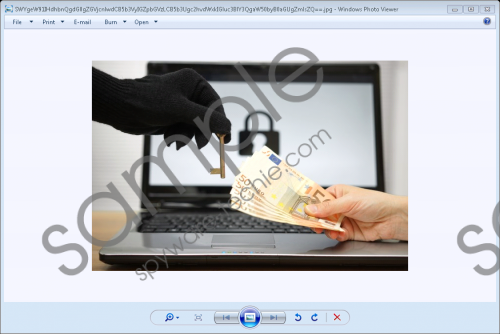Do you know what Ctf Ransomware is?
Ctf Ransomware was first detected at the end of April, 2017 by malware analysts. It seems that it has been developed mainly for educational purposes, so it should not become a prevalent threat. Of course, it does not mean that cyber criminals cannot update it and start spreading it actively in the future. Although it is not a popular infection, you might still encounter it if you are pretty careless, e.g. download software from dubious file-sharing websites every day and keep opening corrupted attachments in spam emails. Most probably, you are reading this article because this has already happened. If so, you need to uninstall this infection from your computer as soon as possible because the longer you keep it installed, the more problems it might cause. Additionally, it might encrypt your files one more time if you accidentally open its launcher. Fortunately, Ctf Ransomware is far from those sophisticated ransomware-type infections which block system utilities, drop a bunch of files in different places on affected computers, and make modifications in the system registry, so its removal should not be arduous.
This ransomware infection has been developed to encrypt files, but it does not do that the second it slithers onto the computer. It first checks %USERPROFILE%\Documents and %USERPROFILE%\Desktop locations and finds files with such filename extensions as .pdf, .doc, .txt, .xlsm, .py, .c, .cpp, and .h there. Then, it encrypts those files so that users could not access any of them. Unlike a bunch of other ransomware infections, it creates copies of those files it encrypts with .ctf extensions, e.g. picture.jpg.ctf and deletes original files. Luckily, if it happens that you encounter Ctf Ransomware, it will encrypt files in two folders only, so you should not lose many files. Strangely, this crypto-threat does not demand a ransom currently although it opens a window requiring a decryption key on Desktop, which suggests that it has primarily been created for educational purposes and should not be distributed with the intention of obtaining money from users. Of course, we do not know what the future holds, so there is still a possibility that it will be updated one day and try to extract money from as many computer users as possible. If you ever become a victim of an updated version of Ctf Ransomware that demands money in exchange for the decryption key, do not rush to spend money on that key. You can recover your files for free from a backup – delete ransomware from your PC first. Ctf Ransomware screenshot
Ctf Ransomware screenshot
Scroll down for full removal instructions
After finding and encrypting users’ files in two directories, Ctf Ransomware opens a window on Desktop. It contains only three words: “Hello… It’s me….” Additionally, there is the box for the decryption key at the bottom of the window. Users could not get the key even if they decide to purchase it because no payment instructions are provided. In addition, a picture SWYgeW91IHdhbnQgdG8gZGVjcnlwdCB5b3VyIGZpbGVzLCB5b3Ugc2hvdWxkIGluc3BlY3QgaW50byB0aGUgZmlsZQ==.jpg is dropped on those affected computers once ransomware finishes the encryption process. If it happens that you encounter Ctf Ransomware and find some of your files locked, you should know that you can decrypt those files for free – our team of specialists has found instructions on how to decrypt files inside the executable file of this ransomware-type infection. Instructions located below this article will help you.
At the time of writing, Ctf Ransomware is not distributed actively, so there is no information about its dissemination either. If the situation changes in the future and cyber criminals start spreading this threat, it will, most probably, travel in spam emails as an attachment too – it is the most popular ransomware distribution method. Ransomware infections are quite dangerous threats, so it is not so easy to prevent them from entering the system. Because of this, a reputable security tool must be active on all computers, our security specialists say.
If you follow our manual removal guide, it should not be hard to delete Ctf Ransomware from the system; however, you will have to put some effort into the decryption of files. If you want your files back, you first need to go to decrypt files and only then eliminate ransomware. Inexperienced users can also use an automatic malware remover to delete this threat from their computers, but they will still have to perform the steps to decrypt files first.
Ctf Ransomware Removal Guide
Decrypt files
- Tap Win+R and enter cmd in the box. Click OK.
- Type getmac and press Enter.
- Copy the MAC address and remove dashes from it leaving only numbers, e.g. 74D53542D375.
- Compute the MD5 of the MAC address (use an online generator).
- Copy and paste the generated MD5, e.g. 363d84f269c69c112c8e91ddc5eef887 in the decryption box located on the window opened by ransomware and click Decrypt.
- Go to delete Ctf Ransomware from your PC.
Delete Ctf Ransomware
- Press Ctrl+Shift+Esc.
- Open the Processes tab.
- Locate the process having svchost in its description and kill it.
- Remove recently downloaded\opened files from %TEMP%, %USERPROFILE%\Downloads, and %USERPROFILE%\Desktop.
In non-techie terms:
In some cases, ransomware infections manage to slither onto computers together with other untrustworthy programs. Also, there are cases when users find ransomware on their systems because malware actively working on the computer has downloaded and installed it without permission. Because of this, our security specialists recommend performing a system scan with an automatic scanner. It will list all active threats, and then you could decide what to do with them. Most probably, there is no need to say that all detected infections have to be deleted from the system as soon as possible.
